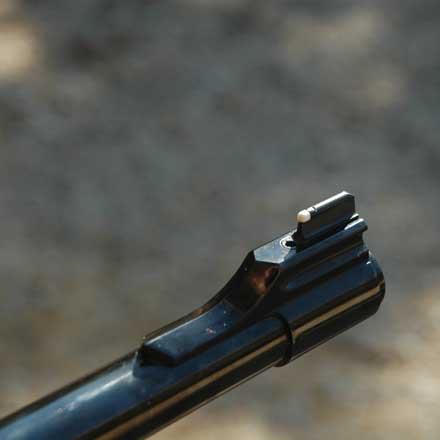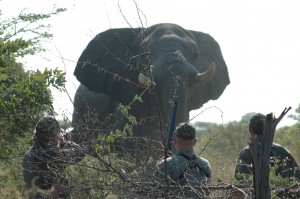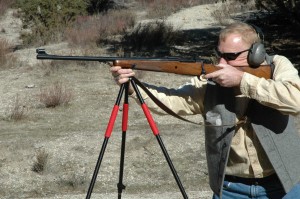
Ken Elliott and I had an argument regarding iron sights that ran for years. Ken, my long-time boss, believed strongly that a centerfire hunting rifle should wear iron sights in addition to a scope, preferably with detachable mounts. I never agreed. Only once in my hunting career have I removed a scope in favor of iron sights, but more about that later.
We see not just better, but also faster, through a scope. It isn’t just the magnification. The larger image does simplify things at longer ranges and on smaller targets, but the real secret to a telescopic sight is matching the magnification to the situation. Many of us, me included, use variable scopes that have, at the upper end, more power than we need, and perhaps because of heat waves and mirage more than we can possibly use. But so long as the lower end allows shooting at close range, this is not harmful. You just need to keep the power ring turned low unless you actually need more magnification.
But the real magic of a riflescope is that it puts both the reticle and the target in the same focal plane. All you have to do is superimpose the reticle onto the target. Even for young eyes this is much faster than lining up the proper sight picture with iron sights. When you’re my age, well, there’s no comparison. There is also no comparison in bad light. You can shoot accurately with any scope long after iron sights are a dim blur, and a really bright scope with good lenses, 30mm tube, and large objective can turn just a bit of moonlight into near-daylight.
So my old friend Ken Elliott’s general-purpose rifles, in versatile cartridges like his 7mm Remington Magnum, wear iron sights. Most of my rifles below .375 in caliber have plain barrels, no iron sights. Or in some cases, just iron sights, no scopes, but more about that later as well. I know myself well enough to know that for most of the game I’m going to hunt with general-purpose cartridges, there is no way I’m going to trade a scope for iron sights. So for me, iron sights on a standard centerfire are extra weight and extra projections to catch on brush. Plain barrels are just fine with me!
There are some caveats. If you have iron sights, you might as well have detachable mounts, otherwise the irons are just for decoration, and thus useless. As above, extra weight, extra projections, and you can add in extra cost. Another caveat is there are some situations where iron sights are just fine. I have...
several lever actions in cartridges like .30-30 and .348 Winchester. These wear aperture sights which are vastly superior to scopes. I don’t use them when longer shots are likely, but I do use them, and I like to use them. In really thick cover, a scope is just a brush-catching projection, and there’s no reason for the weight if you don’t need it. For any big game hunting that involves hounds, whether pigs, bears, or cats, iron sights are actually superior because you don’t need the scope for distance. And just in case the fight takes place on the ground, you don’t want the “tunnel vision” created by a scope. You must be conscious of where the dogs are, and take your shot when it’s safe.

Now with the larger cartridges, my thinking gets a bit more confused. At about .375, my rifles are going to be scoped. But they’re also going to wear iron sights. The scope utilizes the versatility of these medium calibers. The iron sights are because I just might want to remove the scope, perhaps when following a wounded cat or a buffalo. Except, I never have.
Oh, yeah, there was this one time. I had a scope mounted on a .375 Weatherby Magnum, and it didn’t have quite enough eye relief. Every time I pulled the trigger I got a scope cut. This was in Cameroon, and except for a buffalo I had taken the game I wanted. So, tired of bleeding, I took the scope off. At that point in the safari, we had passed several buffalo, all at very close range. Within hours of removing the scope, I got a shot at about 75 yards. Depending on light and circumstances, for most of us this is a long shot for iron sights. I guess it was long at that moment because I didn’t hit him well, and we had a wounded buffalo to track. We got him without incident, but if I’d just left the scope on for one more shot I’m sure we would have been spared some tense moments.
In Africa, the buffalo is on the cusp between scopes and iron sights. There are many who believe the only way to hunt buffalo is with iron sights. I think this is hogwash. I have taken a lot of buffalo with iron-sighted big bores, and it’s fun. But there are many times when the bull of your dreams...
stands at 90 or 120 yards with open ground or watchful cows in between. It’s exciting to get much closer, and I suppose that is the essence of buffalo hunting, but you must surrender a lot of potential shots. Even when you’re very close, you’re often looking at a black animal in black shadow; a scope helps resolve shot placement. I know that you will take more buffalo and bigger buffalo with a scope than is possible with iron sights.

Step a bit, and things change. With elephant, a long shot is 25 yards, and 40 yards is a very long shot. Scopes are not needed for elephant. Moreover, scopes are dangerous. The 25-yard shot is not a problem no matter what sights you are using. But at five yards, the scope may show you a wall of gray with the essential precise aiming point hard to find. Equally important, the real danger isn’t from the elephant you’re shooting, but from other elephants which you may not even be aware. The “tunnel vision” caused by a scope can get you killed. So my “buffalo guns” wear both scopes and iron sights, even though I may never use the latter. My “elephant guns,” which I often use for buffalo, wear plain old iron sights. I practice with them a lot, and this is absolutely essential if you think you might actually use the irons!